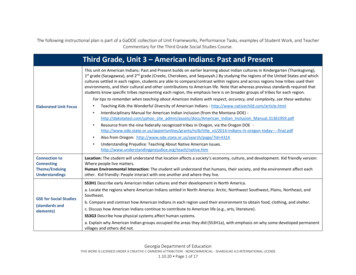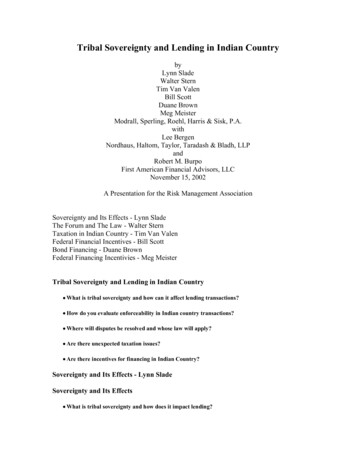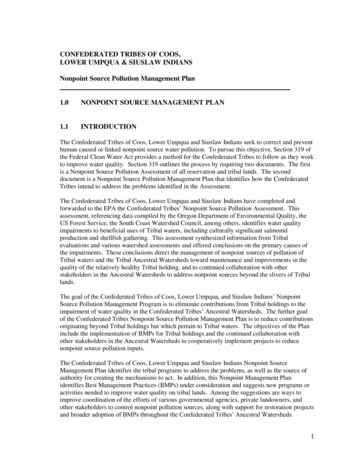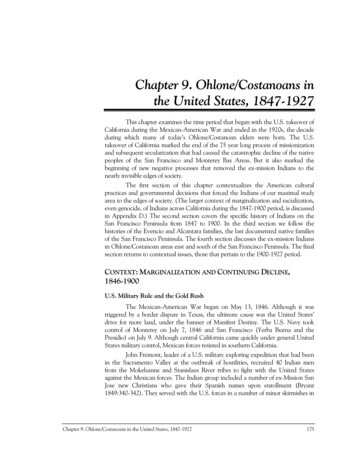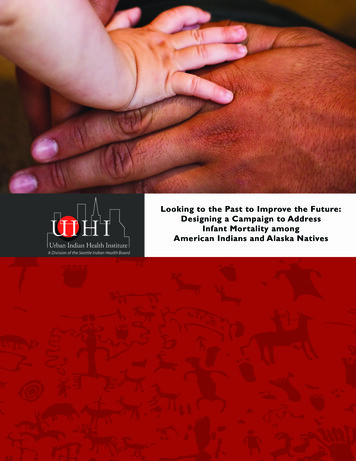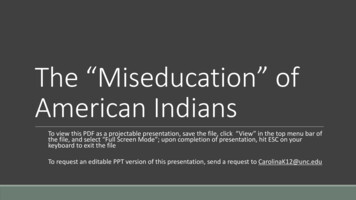
Transcription
The “Miseducation” ofAmerican IndiansTo view this PDF as a projectable presentation, save the file, click “View” in the top menu bar ofthe file, and select “Full Screen Mode”; upon completion of presentation, hit ESC on yourkeyboard to exit the fileTo request an editable PPT version of this presentation, send a request to CarolinaK12@unc.edu
"As a savage, we cannot tolerate him any more than as a halfcivilized parasite, wanderer or vagabond. The only alternative leftis to fit him by education for civilized life. The Indian, though asimple child of nature with mental facilities dwarfed andshriveled, while groping his way for generations in the darknessof barbarism, already sees the importance of education;bewildered by the glare of a civilization above and beyond hiscomprehension, he is nevertheless seeking to adjust himself tothe new conditions by which he is encompassed. He sees that theknowledge possessed by the white man is necessary for selfpreservation.
Education before 1492“Contrary to popular belief, education, the transmission and acquisition of knowledge and skills – did not cometo the North American continent on the Nina, Pinta, and Santa Maria. We Native Americans have educated ouryouth through a rich and oral tradition ” Dr. Henrietta Whiteman-MannvBefore looking at the history of the American government’s attempts to“educate” American Indians, it is important to recognize that Indiannations had their own educational systems firmly in place by the timeColumbus landed in Hispaniola.vSuch education efforts were both formal and informal. Education wasdeliberate, planned, and valued, designed by tribal elders to reflect thesocial, cultural, political, and economic needs of their tribe.vThe inadequate education provided for Indian youth post-Colonizationrepresents yet another way the American government has takenadvantage of and failed Native people.
Colonial PeriodvAs the American colonies took hold, Euro-Americans felt it was important to “Christianize” and“civilize” Native Peoples. (No regard was given to the fact that Native People had their ownreligions, customs, and forms of education.)vBoth George Washington and Thomas Jefferson began formulating policies that would promotethe "civilizing process“ through which Indian people would learn, appreciate, and practice EuroAmerican cultural, social, economic, and political traditions.vColonial missionaries started schools for Native children.Missionaries were trained to convince Indians (who wouldcertainly be untrusting and resist sending their children tocolonial schools) that free room and board in a charity schoolwas the key to their child's survival in an increasingly hostilecolonial environment.vColonial attempts to use education to “civilize and Christianize”American Indian children failed, however. Few Indians attended and even fewer graduated.
Into the 1800svWithin 20 years after the Constitution was signed,two separate systems of Indian education haddeveloped:ütribal education organized and operated by variousIndian nations;üfederally-subsidized education organized andoperated primarily by Euro-American Christianorganizations.
Tribal EducationvIn the early 1800s, several nations established sophisticated school systems for their children. TheCherokee and Choctaw created an education network which included over 200 classrooms.vAmong the Cherokee, tribal literacy and journalism flourished as newspapers were published in bothCherokee and English languages. Their motive was clear, according to a Cherokee elder's advice toyounger tribal members,"Remember that the whites are near us. With them we have constant intercourse, and you mustbe sensible, that unless you can speak their language, read and write as they do, they will beable to cheat you and trample on your rights." (Nabokov, 1991:215.)vIn 1851, the Cherokee National Council created the Cherokee National Female Seminary that was operated bythe Cherokee Nation, not the federal government. At the Seminary, Cherokee girls took courses in Latin, French,trigonometry, political economy, and literary criticism. They also staged dramatic productions, held music recitalsand published their own newsletter.
Federal Education: Mission SchoolsChurch & State partner to “educate” American IndiansvDespite Indian interest in education that could help tribal members cope withthe endless flow of Euro-Americans into tribal lands, the federal governmenttook an entirely different path.vIn 1819, the U.S. government created a "Civilization Fund" which providedfederal funds to churches and missionary organizations to run schools (MissionSchools) designed to “educate Native Americans in the ways of the white man.”vThe goal was to "civilize" Native Americans by getting rid of their customs,traditions, religions, etc. while teaching them to read and write in only English.vThe Bureau of Indian Affairs (BIA) was created in 1824 by the federalgovernment (and tellingly placed into the U.S. Department of War) to administerthe funds given to the schools.
The Indian Removal Act (1830) &Manual Labor SchoolsvThe Indian Removal Act was signed into law May 28, 1830, authorizing the president to grantunsettled lands in the west in exchange for Indian lands within existing state borders. A few tribeswent peacefully, but many rightfully resisted the unjust relocation policy.vA Commissioner of Indian Affairs was appointed (also positioned in the U.S. Dept. of War) todeal with removed tribes and charged with figuring out a system to “reeducate” Indians to live“domesticated” lives in their new land.vThe unfair and racist system of Indian education that resulted – manual labor schools emphasized vocational training as the ideal to assimilate Indians into industrial society.
The Indian Removal Act (1830) &Manual Labor SchoolsvManual labor schools turned the alleged “moral” project of“civilizing Indians” into a for-profit exercise, benefiting the religiousgroups running the schools and supported by the government.vUnder this model, churches were provided hundreds of acres ofland for Indian children to plow, maintain and harvest. Manychurches made high profits form the free labor of AmericanIndians, creating increased competition for federal funding ofmore manual labor schools.vIronically, it was the competitive friction among rival churchesthat contributed to the repeal of the Civilization Fund in 1873.
"Kill the Indian in him, and save the man."
Boarding SchoolsvBuilding on models established by manual labor schools, the government looked to define a newsystem of Indian education.vFederal planners did not like day school models, which they felt kept Indian students too close andconnected to their families and communities. (Such access made the overall goal of assimilation anddeculturalization unsuccessful.) Thus, boarding schools became the model of choice.vThe infamous Carlisle Indian School (1879-1918) was the first such boarding school. Richard Pratt, itsfounder, attacked the tribal way of life as socialist and contrary to American values of civilization."Kill the Indian in him, and save the man." Capt. Robert H. Pratt, 1892 (founder of Carlisle School)
Boarding SchoolsvBy 1900, the Bureau of IndianAffairs was opening 25 suchboarding schools in 15 states.vEventually, over 100,000 childrenwere sent to over 500 such schoolsthroughout the United States.
Boarding SchoolsvLike earlier models, boarding schools were designed to serve the purposes of the federalgovernment, not the needs of Indian children.vThe “education” process began with the (often forcible) removal of young children from theirhomes and communities and transporting them to places that were foreign to them (both inlocation and in customs.)vUpon arrival, students were subjected to English-only, Anglo-centric curriculum and “patrioticpropaganda.” Native languages, customs and religions were purposely excluded.vAnother central feature was teaching “work ethic” through forced manual labor. (In his annualreport in 1881, Commissioner of Indian Affairs Hiram Price argued that previous attempts to“civilize” Indians failed because they did not teach the “necessity of labor”.)vChildren were often undernourished and subjected to overcrowded living spaces.vCompulsory attendance laws meant that families has no choice in whether to send their childrento these unjust boarding schools.
Warm-Up ActivityvConsider the history you have learnedregarding the American government’spolicies for “educating” American Indiansand how important it is that this history beacknowledged.vDesign a t-shirt that addresses thishistory in some way. The purpose of theshirt is to call attention to themiseducation of Native People throughouthistory.vYour shirt can include pictures, words,phrases, etc. Be creative!
Boarding Schools to Segregated Public SchoolsvEventually, the boarding school experiment began to fail. Schools were becoming overcrowdeddue to the government’s compulsory attendance laws, federal funding decreased, and resistance tothe injustice grew among tribes, all of which made the system too problematic for federal officialsto maintain.vNot only did the schools become political and economic liabilities, but they also proved to beineffective in achieving the government’s aim of “assimilation.”vNative languages, spiritual practices, and other customs were not only continued by tribalelders, but passed down from generation to generation.vIn 1906, Commissioner of Indian Affairs Francis Leupp initiated the next plan – the transfer ofIndians into public schools. The government believed this would not only savemoney, but would also help with their goal of “Americanizing” Indian children.vHowever, public schools would not be the perfect solution. With segregation infull effect during the 1900s, American Indians would experience racism andunequal schooling in the public system.
The Meriam ReportvIn 1928, an independent investigation of the Indian Office by the Brookings Institution, knownas the Meriam Report, sharply criticized the quality of education provided by government-runIndian schools.vThe report was especially critical of vocational education programs, which it noted were usedto provide student labor to keep the schools running and save the government money. Thereport also harshly criticized the policy of removing Indian children from their homes andcommunities and the severe discipline they experienced at boarding schools.vThe report called for more child-centered, culturally appropriate education in keeping with thethen-current philosophy of progressive education.vThe report summarized that the most fundamental need in Indian education was a “change ingovernment attitude.”
John Collier and the “Indian New Deal”vIn 1933, leading reformer and advocate of Indian rights John Collier became the Commissionerof Indian affairs.vHe oversaw the implementation of many of the recommendations in the Meriam Report,including increased Indian religious freedom and greater tribal self-government.vThe Johnson-O’Malley Act (1934) was also passed during Collier’s term, which authorizedpayments to states or territories for the education of Indians in public institutions.vSuch reforms were features of Collier’s Indian New Deal, the impact of which significantlyincreased the number of Indian children being served by both federal (BIA) and publiceducational institutions.vThe idea of reform, made popular by Collier’s New Deal, increased sentiments to “free” theIndian from government control, particularly from the reservation system.
“Self-Determination” & theCivil Rights MovementvBy the 1960s, tribes had developed a core leadership capable ofarticulating Indian rights and concerns.vIn addition to their protests of existing federal policies, the new Indian leadership advocated an agendaof self-determination, or the idea of “letting Indian people decide their own destiny”vThe spirit of self-determination gave rise to several Indian organizations, such as National IndianEducation Association (1967), the Coalition of Indian Controlled School Boards (1971), and the AmericanIndian Movement (1972).vThe political energy created by such groups helped to energize efforts to create tribally controlledschools.vIn 1966, Rough Rock Demonstration School opened in the Navajo Nation in Arizona as the first Indiancontrolled school in modern times.vCiting the high college-dropout rate for Native students, the Navajo tribal council passes a resolutionfounding Navajo Community College (renamed Diné College in 1977), the first tribal college. In 1978,Congress passes the Tribally Controlled Community College Assistance Act. Today, there are 35 tribalcolleges in 13 states.
Haliwa-Saponi Tribal SchoolvIn 1957, the Haliwa-Saponi opened one of the first tribal schools in theUnited States.vAt the height of the Jim Crow Era, Native students were experiencingracism and inadequate schooling in segregated public schools. Tribal schools were one solution.vFrom 1957-1969, the Haliwa-Saponi built, maintained, and operated the Haliwa Indian School,one of the first tribal schools in the U.S. and the only non-reservation, tribally-supported Indianschool in the state.vTribal members paid for supplies and materials, the building, and maintenance out of theirown pockets. Teachers were initially paid by donations taken up by the Tribe. (After a few yearsof operation, the state Department of Public Instruction provided funding for teacher salaries.)vWhile the school shut down in 1969, it was reopened in August 2000. The school includes acurriculum based on standard course of study, small classrooms, technology, and AmericanIndian Studies. It promotes the cultural and traditional heritage of the Haliwa-Saponi people ofHalifax and Warren Co.
Indian Self-Determination and EducationAct of 1975vThe efforts of Indian educators and leaders also prompted the publication of twomajor studies in Indian education: Indian Education: A National Tragedy – A NationalChallenge (U.S. Senate, 1969) and The National Study of American Indian Education(1970)vThese reports helped secure passage of the Indian Self-Determination andEducation Act of 1975, which provided American Indians increased control overtheir children’s educationvThe act authorized special funding for programs in reservation schools and for thefirst time, off-reservation urban schools.vIt also advocated for parent involvement in program planning, for theestablishment of community-run schools, and for culturally relevant and bilingualcurriculum materials.
Reports paint a gloomy picture of IndianEducationvSeveral reports were also published during the era of self-determination, suchas the Indian Nations at Risk (1991), the White House Conference on IndianEducation (1992), and the Executive order on American Indian and Alaska NativeEducation (1998). In general these reports indicate that while progress had beenmade in Indian education, the road ahead held many challenges.vOverall, it was reported that:o Indians have the highest dropout rates and the lowest achievement rates.o Most Indians were subject to schools with Euro-centric curriculums, high teacher turnover,underprepared teachers, limited access to cultural learning resources, limited access totechnology and computers, and racism. These problems were deepened by a decline in federalspending.o Centuries of racism, genocide and assimilationist polices cannot be undone in a matter ofyears.
Reports pain a gloomy picture of IndianEducationvIn 2001, the “Comprehensive Federal Indian Education PolicyStatement” was released. It stated that school reform must besystematic and inclusive of all aspects of tribal life. Therelationship between educational reform and the struggles topreserve tribal homelands, governments, languages, cultures,economies, and social structures is made explicit.vThis report served as the model for “The Executive Order onAmerican Indian and Native Alaskan Education” issued in 1998 bythe Clinton administration. This issue of this executive order was ahistoric moment, symbolizing the efforts of contemporaryAmerican leaders to support self-determination but also thegovernments acknowledgement of this inherent right.
vWhile progress has been made, Indianstudents, in comparison to all others, arestill the most disproportionally affected bypoverty, low educational attainment, andlimited access to educational opportunities.vAdditionally, the number of Indian youth(12-17 yrs.) engaging in high-risk behaviorsis vast. For example, drug use is more thantwice the national average and alcohol useis higher than the national average.
Toward True Native Education:A Treaty of 1992“It is time for a new treaty, a Treaty of 1992, to end a shameful, secret war. For five hundred years, ourtribal people have been resisting the siege of the non-Native societies that have developed in our nativeland.Our children face the consequences of this war today. Every tribal member has felt the bitter painsof this relentless siege. It dominates our lives. It is killing our children. It is destroying our Nativecommunities.”-“Toward True Native Education: A Treaty of 1992,” Indian Nations at Risk Task Force(1994)vIn 1992, the Indian Nations at Risk Task Force published a report placing the liability for the failings ofAmerican Indians’ education in the hands of the U.S. government. Yet, it also notes that change will onlyoccur when Native and nonnative societies make the commitment to work together.vThe report summarizes that Native nations are struggling because:o Schools have failed to nurture the intellectual development and academic performance of Native children.o Indian lands and resources are constantly being besieged by outside forces.o Relationships between tribes and the federal government fluctuate with the will of the U.S. Congress and decisionsby the courts.
Read and discuss the quote provided toyou:vWhat does the quote provided tell you regarding the history of therelationship between indigenous peoples and Euro-American colonists?vWhat does the quote tell you about the history of American Indianeducation?vWhere do we go from here? Imagine you have been named as a memberon a task force for improving the education of Native Americans. Whatideas do you have? Whose assistance would you need and why?
v"The white man's superior technology, hunger for land, and ethnocentrismseemingly knew no bounds. The white threat to Indians came in many forms:smallpox, missionaries, Conestoga wagons, barbed wire, and smokinglocomotives. And in the end, it came in the form of schools." Cornell Pewewardyv“Understanding the “the Indian problem” is not a problem of children andfamilies but rather a problem that has been consciously and historicallyproduced by and through the systems of colonization: a multidimensional forceunderwritten by Western Christianity, defined by white supremacy, and fueledby global capitalism.” Sandy Grandev“Indian education was never simply about the desire to “civilize” or evendeculturalize a people, but rather, from its very inception, it was a projectdesigned to colonize Indian minds as a means of gaining access to Indian labor,land, and resources.” Sandy Grande
THE CARLISLE INDIAN INDUSTRIAL SCHOOL:This school was the model for anationwide system of boarding schoolsintended to assimilate AmericanIndians into mainstream culture. Over10,000 indigenous children attendedthe school between 1879 and 1918.Despite idealistic beginnings, theschool left a mixed and lasting legacy,creating opportunity for somestudents and conflicted identities forothers. In this cemetery are 186 gravesof American Indian students who diedwhile at Carlisle.
SourcesRed Pedagogy: Native American Social & Political Thought, Sandy Grande (2004)http://americanindiantah.com/lesson plans/ml ndiantah.com/lesson plans/ml rican ve-american-education/running-in-place.html
The "Miseducation" of American Indians To view this PDF as a projectable presentation, save the file, click "View" in the top menu bar of the file, and select "Full Screen Mode"; upon completion of presentation, hit ESC on your . designed to "educate Native Americans in the ways of the white man." vThe goal was to "civilize .




